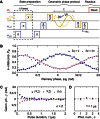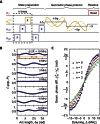Measurement of a vacuum-induced geometric phase
- PMID: 27386533
- PMCID: PMC4928991
- DOI: 10.1126/sciadv.1501732
Measurement of a vacuum-induced geometric phase
Abstract
Berry's geometric phase naturally appears when a quantum system is driven by an external field whose parameters are slowly and cyclically changed. A variation in the coupling between the system and the external field can also give rise to a geometric phase, even when the field is in the vacuum state or any other Fock state. We demonstrate the appearance of a vacuum-induced Berry phase in an artificial atom, a superconducting transmon, interacting with a single mode of a microwave cavity. As we vary the phase of the interaction, the artificial atom acquires a geometric phase determined by the path traced out in the combined Hilbert space of the atom and the quantum field. Our ability to control this phase opens new possibilities for the geometric manipulation of atom-cavity systems also in the context of quantum information processing.
Keywords: Berry phase; circuit-QED; transmon; vacuum fluctuations.
Figures




References
-
- Xiao D., Chang M.-C., Niu Q., Berry phase effects on electronic properties. Rev. Mod. Phys. 82, 1959–2007 (2010).
-
- Thouless D. J., Kohmoto M., Nightingale M. P., den Nijs M., Quantized Hall conductance in a two-dimensional periodic potential. Phys. Rev. Lett. 49, 405–408 (1982).
-
- Hasan M. Z., Kane C. L., Colloquium: Topological insulators. Rev. Mod. Phys. 82, 3045–3067 (2010).
-
- Qi X.-L., Zhang S.-C., Topological insulators and superconductors. Rev. Mod. Phys. 83, 1057–1110 (2011).
-
- Zanardi P., Rasetti M., Holonomic quantum computation. Phys. Lett. A 264, 94–99 (1999).
Publication types
MeSH terms
LinkOut - more resources
Full Text Sources
Other Literature Sources
Research Materials

